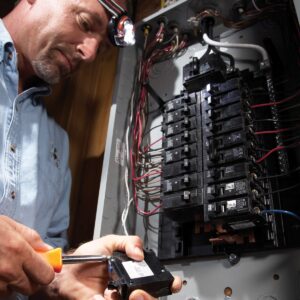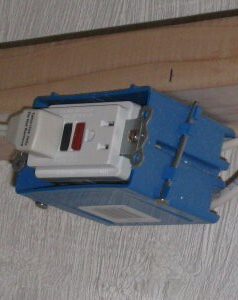New Electrical Circuits
Just because you have sufficient power for your home now is no guarantee that it is going to accommodate any additional demands that you place upon it. While many homeowners are under the impression that just adding circuits to the breaker box will handle any additional demands, this isn’t always the case
Most homes are outfitted with an electrical panel that is suited to its electrical requirements, with a little room for increased electricity. Adding a circuit or two might be just fine to accommodate your new electrical needs, but it’s quite easy to exceed the safe threshold if you’re not careful.
Instead of just adding circuits in the hope that it will be enough for your needs, it’s best to have your circuits and electrical panel evaluated by a certified Los Angeles electrician. When do you need to look into adding circuits or updating your electrical panel?
Any time you add an appliance to your home, you are increasing the demand on the electrical system. Consult with a licensed electrician before hooking up a major appliance to determine if your system is ready for the added load.
Whenever you set up a big holiday light display, this is one of the leading causes for needing upgraded circuits.
EV Car Chargers will require there own 120 Volt or 240 Volt electrical circuit.
Hot tubs draw a lot of electricity and are almost always a time for a new circuit installation and potentially upgrading your electrical panel.
If adding a new room to your house or other additional square footage is added, this will need to be accommodated by adding one or more new circuits to the system. Depending on the size and electrical requirements of your addition, the increase in amperage could require updating the electric panel as the only viable option.
If you’re unsure about the best course of action, consult with the professionals at The Electric Connection. We’re always happy to talk with you about all of your options over the phone. We’re happy to schedule an appointment at your property to provide a free estimate, too, and to give you an in depth consultation in order to pick the very best course of action for your situation.

Breaker Box Safety: How to Connect a New Circuit
Introduction
Adding a new circuit can be a daunting and even dangerous job. We show you how to do it with step-by-step instructions and important, life-saving safety tips.
Tools Required
Flashlight
Needle-nose pliers
Pliers
Utility knife
Voltage tester
Wire stripper/cutter
Materials Required
AFCI circuit breaker
Cable clamp
electrical staples
Know What You’re Getting Into
We believe in safe DIY. That’s why we’ve always been reluctant to show readers how to open a breaker box and connect a new circuit. Even with the power shut off, there’s a chance you could touch the wrong parts and kill yourself. But then we figured if we didn’t show you, you’d just go search it somewhere else. And that scared us even more. So we’re going to walk you through the process, showing you the safest way to open the breaker box, wire a new breaker and test your work.
Opening the main circuit breaker panel box and adding a circuit is actually pretty easy. You only have to connect three wires to add a circuit, and each circuit wire is color-coded. But there are some safety precautions, and if you ignore them, you could kill yourself. Really. If you follow our safety steps in order and to the letter, you’ll be fine. But if at any point you’re unsure how to proceed or feel uncomfortable with the project, call an electrician.

How to Run a New Electric Circuit from a Breaker Panel
Running a new electric circuit is a pretty simple task that can be accomplished with a little bit of effort, care, and the right tools. This article is focused on running a new circuit for light fixtures or outlets. The same principals apply to all 110V circuits, and slightly modified instructions can be used for 240v circuits
Tools & Materials Required to Run a New Circuit
Wire strippers.
Pliers or wire cutters.
14/2 or 12/2 Romex wire in the length required (see below).
Electrical boxes.
Receptacles.
Wire staples.
Hammer.
Phillips and flat head screwdrivers.
Electric Code & Regulation Concerns for Running a Circuit from the Breaker Panel
To meet code in most areas you must obtain a permit and have your work inspected by the local electric inspector. In some jurisdictions you can only perform this work if you are a licensed electrician, even if the work is in your own home. Check your local government’s web site for details.
Almost all jurisdictions enforce either the 2005 or 2008 National Electric Code (NEC). You can read the 2005 and 2008 NEC online for free, just follow the instructions in that article for how. If you’re new to electrical work or looking for some helpful guidance, we highly recommend picking up a good instruction manual.
15 or 20amp Circuit: Select the Right Wire for the Amperage
Lighting and receptacle circuits in a house are 110v, 15-amp, or 110V, 20-amp. For 15-amp circuits, 14/2 (meaning, 14 gauge, 2 conductor) Romex is appropriate. For 20-amp, 12/2 Romex is appropriate. Note that 14/2 and 12/2 wire will actually have 3 wires inside: a black, white, and ground wire. Remember, as gauges go up, the size of the wire goes down. Do not install a breaker that is too large for the wire. (E.g., do not install a 20amp breaker on 14/2 wire). This is unsafe and could lead to a fire.

The Complete Guide to Electrics in the Home Including Wiring and Circuits, Switches and Sockets and Lighting
Everything You Need to Know About Wiring and Circuits – How and When You Can Do Wiring Yourself and When to Use 110 Volts and Why
Understand all aspects of Wiring and Circuits when working with electricity in your own home
Chases – cutting and filling – DIY Doctor’s advice on cutting chases in walls using a chase cutter and how to cut electrical chases and fill them for plastering afterwards
Consumer unit – Help and advice on how to install a consumer unit within your home with instructions on wiring a consumer unit to specifications for dual RCD and RCBO consumer units.
Electrical – adding a spur socket – How to add spur sockets and fused spur sockets to a circuit. How to add new sockets to an existing circuit
Electrical – cable sizes – How to check electric cable sizes for the correct amp ratings and kilowatts DIY Doctors tables below show two different cable and amp ratings
planning circuits for new home
I am beginning to plan my electric circuits for my new home. Here is a couple circuits I planned. Just looking for opinions to see if I somewhat know what I am doing… but then again maybe not
I would keep the receptacles and lights separate. Use 14ga wire for the lighting, it will help alot with multigang switches and box fill. The 20A dining room receptacles cannot be shared with lighting as they are considered part of the small appliance circuits [210.52(B)(1)2002]. You can have 15A switched receptacles however, in addition to the other.
I’m a DIY with over 30 years of wiring experience, and I’d only undertake a complete house wiring job if I didn’t have a day job at the time. It’s far from trivial, especially when you have to look up every new situation to see what code allows.
rewired a few old houses, but wiring a new house is very different. With the former, you can do one circuit at a time, often leaving much of the old wiring in operation until you’re ready to cut over. In DIY rewiring, it’s usually no big deal if it takes you 3-4 years to finish the job. But for new construction there are lots of problems with that approach, from mortgage lenders who want the house done, to family members who usually aren’t too keen on fixing dinner on a stove by the light of clip-up work lights.
There are only a few dining receptacles. My plan was to have two or three small appliance circuits for the kitchen receptacles – so if can add these 3 to one of the circuits that would work.
